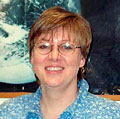 |
|
|
| Author |
Message |
Patty_Cie

Joined: 23 Mar 2004
Posts: 87

|
 Posted:
Wed Jun 02, 2004 7:00 pm Posted:
Wed Jun 02, 2004 7:00 pm |
  |
May 30, 2004 Sunday
9:20 AM Alaska time
Today I followed Glenn Cota’s optics group from Old Dominion University, Norfolk, Virginia. Dr. Cota is not on the SBI 04 cruise, however, his work is proceeding with research associate, Dave Ruble, post-doctorate research associate, Victoria Hill, and PhD student, Xiaoju Pan. They are taking measurements, collecting samples and recording data for four separate, but related, components: productivity, active optics, passive optics and discrete bio-optics. Additionally, if there is enough open water, Dave gets surface optics data from equipment mounted on the top of the Healy and if it is bright enough, he takes measurements of ozone thickness. Their purpose is to further understand the relationships between particles found in the water column and optical characteristics (how light behaves, absorption and scattering). Through this relationship, they aim to help scientists monitor the Arctic Ocean from space using remote sensing satellites.
Productivity
The productivity component of the project measures how fast phytoplankton grows. This component is time sensitive and samples must be collected between 6 and 9 AM, when phytoplankton are at the beginning of the daily photosynthesis cycle. A productivity cast is made when we are in enough open water to send down a CTD package during the required time window. To get the exact water depths needed for sampling, Victoria peers over the side of the Healy, watching the CTD package descend into the sea. On top of the package is a rod and on top of the rod is a white circle called a Secchi disk. As the package is lowered further down, the Secchi disk becomes less visible because light is being absorbed and scattered by the water. At the exact moment Victoria can no longer see the Secchi disk, she waves to the CTD operator who records the depth. Before the CTD package is raised, Victoria uses a conversion chart to determine the exact depths needed to collect phytoplankton samples. She needs water collected at depths with six specific percentages of surface-light exposure: 1%, 5%, 15%, 30%, 50%, and 100%. Once she has made the conversions and knows the required depths, the CTD operator who raises the package slowly, firing (closing) rosette bottles at each of the needed depths.
After the samples have been collected from the rosette bottles, 10 microliters of carbon-14 tracer is added to each sample. (When the phytoplankton take in nutrients they will also take in carbon-14.) The samples are placed in the same temperature and light levels where each sample was captured. After 24 hours, the samples are removed from the incubator and filtered. Next, a scintillation liquid is added. The scintillation liquid does two things: 1. It separates the sample from the filter and 2. It reacts with carbon-14 making it fluoresce. Finally the samples go through a scintillation counter. The counter puts a pulse of light through the sample and measures the amount of fluorescence. By measuring the fluorescence, the group can tell the rate at which the phytoplankton community is growing biomass.

CTD package being lowered into the water for a productivity cast. The white circle located above the rosette is called a Secchi disk. A relationship exists between the depth the Secchi disk disappears from view and the amount of light being absorbed and scattered by the water column.

Victoria signals to the CTD operator when she can no longer see the Secchi Disk.
Active Optics
The active optic package sends out light pulses through the water column to measure the optical properties of the water. One part of the package is called an ac9. It measures the light absorption and attenuation (absorption plus scattering) at nine different wavelengths within the visible light spectrum. There is also a Hydroscat 6 that measures back scattering. Back scattering is the amount of light that is reflected back toward the surface.
Passive Optics
The passive optics equipment measures the natural light field in the water column. As it makes its freefall descent, the equipment records the natural light reflected back to the surface and the natural light penetrating to depth. Additionally, it has a sensor that continuously measures surface light so the group can make comparisons between the amount of light at the surface and the amount of light reaching depth.

Xiaoju Pan brings in the active optics package.

Dave Ruble holding the passive optics equipment.
Discrete Bio-opic Measurements
To make discrete bio-optic measurements, Dave, Victoria and Pan use water from the CTD at the same six depths used in the productivity component. The water is poured through a filtering apparatus, separating the insoluble particulates (algae and sediments) from the dissolved substances. The insoluble particulates are trapped on a filter. The soluble substances pass through the filter and are collected into small bottles in the filtering apparatus. Then Pan measures the light absorption for both the soluble and insoluble substances using a spectrometer. Next, the insoluble particulates are bleached with methanol and measured again. Methanol removes the algae, leaving just the sediments. In this way, they can get an algal measurement (Total absorption – sediment absorption = algae absorption). The data is then analyzed in conjunction with the active and passive optics.
Additional Work – Faster Methods
The group also sends samples to a lab for High Performance Liquid Chromatography (HPLC). HPLC measures the concentration of all the different pigments in the sample. The pigments allow scientists to identify phytoplankton faster than by conventional identification methods.
Furthermore, they are filtering water through traditional glass fiber filters to determine the amount of total suspended materials in grams per liter units. They are trying to establish a relationship between the suspended materials found through traditional filtering methods and the data collected by the optical instruments. If they find a relationship, rather than spending time (and money) to filter water, scientists will be able to use optical equipment to determine total suspended materials in water.
To see photographs taken by Steve Roberts of UCAR/JOSS, click here. |
|
|
    |
 |
|
|
|
View next topic
View previous topic
You cannot post new topics in this forum
You cannot reply to topics in this forum
You cannot edit your posts in this forum
You cannot delete your posts in this forum
You cannot vote in polls in this forum
You cannot attach files in this forum
You can download files in this forum
|
Powered by phpBB 2.0.11
© 2001, 2002 phpBB Group :: FI Theme ::
All times are GMT
| |
